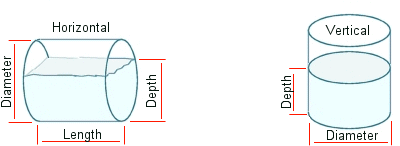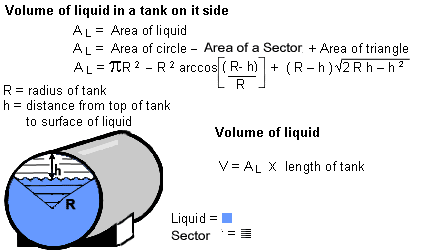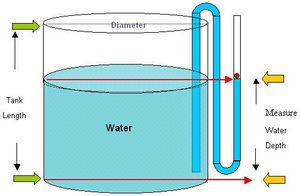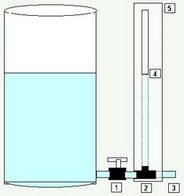Calculate the amount of water that can be stored in your water tank.
1: Tank Volume Calculator with Dipstick Chart. New
2: Volume of a Horizontal and Verical cylinder in Gallons or Litres.
3: Volume of a Verical cylinder in Litres.
4: A Simple External Rainwater Tank Gauge.
Calculate amount of water that can be collected from your roof.
Calculate the Diameter if you know the Circumference.
Various useful Calculators.
The Dipstick Table:
The table
will show you the Liquid Depth in Centimetres and the corresponding
Litres in the tank in 1 centimetre increments measured from the bottom to completely full.
The outcomes pertain to: A perfectly cylindrical tank,
with completely flat top and bottom ends,
which is not tilted in any way and
can be filled to the hilt.
If the cylinder is domed at the top then measure the height excluding the dome.
One millimeter of rain on one square metre of roof equals one litre

A comprehensive analysis and formulae to calculate the volume-depth relationship for several container shapes such as cylinders, spheres and cones can be found in the publication,
Producing a Scale to Indicate the Volume of Liquid in a Container by S.B. Samat & C.J. Evans (2)

Image source courtesy of Government of Alberta Agriculture and Rural Development (1)
( π = 3.14159 , R = radius , h = height )
| Vertical Tank: (Mouse over arrows) | ||||||||||||||
|

50 % Full 
|

|
Filled to a depth of 1000 mm the tank contains a volume of 3141.59 litres Total Volume of tank 6283.19 litres Total Surface Area of tank 18.85 m² Circumference of tank 6283 mm |
|||||||||||
A Simple External Rainwater Tank Gauge.
(a) (b)
(b) 
![]() Use this calculator to calculate the
volume of Rainwater collected in your tank.
Use this calculator to calculate the
volume of Rainwater collected in your tank.
. Enter the amount of rain in mm and the collective Roof area.( Square metres )
(a) Construction:
Obtain a length of clear plastic tubing ( diameter 10 mm ) to configure as per diagram.
Insert into opening at the top of the tank and lower to the bottom then form the desired u bend.
Fill tube with water and drop a coloured float ( anything that is inert and floats on top of the water. ) for easier viewing.
This tube can then be attached to a board which can be graduated.
To calculate the depth of water in your tank just measure the distance from the bottom of the tank to the level shown on your tube.
Enter this data into the calculator and you will get the remaining volume of water in your Tank.
Note: If you do not want to insert plastic tubing into your water tank then use a stainless steel tube which is inserted into the tank to the top of the tank and then attach your plastic tubing.
(b) Another Simple External Rainwater Tank Gauge.
1: Tap 2: T piece 3: To Pump 4: Clear plastic Tube 5: Board which can be graduated
The clear plastic tube should be attached tightly to the T tube with a hose clamp.
The calculations on this page are a purely theoretical exercise!
For precise
measuring of the liquid volume inside a particular tank, the tank must be
calibrated by professionals of the local official calibration
authorities.
Reference:
(1) Source: Tank Volume Calculator (On side) Government of Alberta
Alberta Agriculture and Rural Development.
Website: http://www.agric.gov.ab.ca/app19/calc/volume/tank.jsp
(2) Further Reading: Producing a Scale to Indicate the Volume of Liquid in a Container.
S.B. Samat
School of Applied Physics, Universiti Kebangsaan Malaysia
43600 UKM Bangi, Selangor D.E., Malaysia and
C.J. Evans
School of Health Science, Swansea University, Singleton Park
Swansea SA2 8PP, United Kingdom
Abstract and file download: http://pkukmweb.ukm.my/~jsm/english_journals/vol39num1_2010/contentsVol39num1_2010.html
Abstract: http://pkukmweb.ukm.my/~jsm/english_journals/vol39num1_2010/vol39num1_2010abstract16.html Accessed 11/2/2010
Calculate the amount of water that can be stored in your water tank. ( 1 page )
by Romsey Australia is licensed under a Creative Commons Attribution 2.5 Australia License.


Revised January 2012